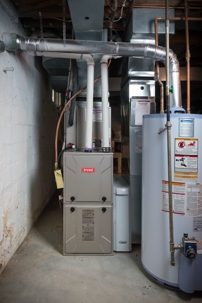 Nathan Wallace is a Senior Service Technician and expert in HVAC maintenance and repair at Standard Heating & Air Conditioning, where he has worked since 2001. Nathan is happy to share his knowledge about how your furnace and heat exchangers work.
Nathan Wallace is a Senior Service Technician and expert in HVAC maintenance and repair at Standard Heating & Air Conditioning, where he has worked since 2001. Nathan is happy to share his knowledge about how your furnace and heat exchangers work.
Many homeowners don’t know what heat exchangers are or even where they are in their homes until something goes wrong with theirs. When your furnace is in good working order, it’s easy to forget that the heat exchanger is the largest component of the furnace. Like all man-made devices, time and use take their toll on heat exchangers, and can result in cracks or holes forming. When this happens, the result can be a furnace that produces incomplete fuel combustion and unacceptable levels of carbon monoxide (CO), a potentially unsafe condition. Carbon monoxide entering your home, either through poor venting or leaks in the heat exchange, can cause serious illness or even death.
What is a Heat Exchanger?
There are many different types of heat exchangers, but what does a heat exchanger do? Their purpose is to safely transfer heat, and they have many applications, including space heating, refrigeration and cooling, power stations, chemical plants, and other processes.
This blog is about the types found in a forced-air furnaces, like the ones in many Twin Cities homes.

How Do Heat Exchangers Work?
Heat exchangers, metal shells, and tubes work by transferring heat from one place to another. When a furnace burns natural gas or propane fuel, its exhaust/combustion by-products (also known as flue gas) enter and travel through the heat exchanger. The hot flue gas heats the metal as the gas makes its way to the exhaust outlet of the furnace. As this is happening, the hot metal heats the air circulating over the exterior of the heat exchanger.
Primary Heat Exchanger
This part contains the hottest flue gas, found closest to the burners in a furnace. As a result, the flame and heat subject it to the most stress, which can cause cracking and heat stress over time. Furnaces that are 70-80% efficient have one heat exchanger. The more efficient a heat exchanger is, the less energy needs to be spent heating your home. Some furnaces only have a single heat exchanger, but more efficient ones often also have a secondary heat exchanger.
Secondary Heat Exchanger
If you have a furnace that is considered high-efficiency (90%+ efficient), it contains both a primary and secondary heat exchanger. As the combustion exhaust leaves the primary heat exchanger, it travels into a secondary heat exchanger where more heat is released from the flue gas and water vapor begins to form. This change of state from water as a vapor to a liquid releases latent heat in the secondary heat exchanger, bringing the furnace to an even higher level of efficiency. This is why high-efficiency furnaces are sometimes referred to as condensing furnaces. Secondary heat exchangers are generally constructed from stainless steel or a coated steel material capable of withstanding heat, moisture, and acid.
Health Risks of a Damaged Furnace Heat Exchanger
Because heat exchangers contain the flue gas, it is important there are no holes, cracks, or other deterioration. This type of deterioration that permits leakage and mixing of flue gas with the air being heated can result in incomplete combustion and the formation of carbon monoxide and other harmful by-products. Although your furnace may not immediately leak carbon monoxide into the living space, high CO levels make it unsafe to operate. Something as simple as the chimney getting plugged in or a damaged exhaust pipe can result in a very dangerous situation.
How to Detect Heat Exchanger Problems in Your Furnace
Unless your furnace is malfunctioning or your carbon monoxide detector is going off, it’s nearly impossible to know if your heat exchanger has developed problems without direct inspection or testing for CO. This is why regular maintenance and inspections are very important. An inspection and a combustion analysis/CO test is the best way to determine whether the furnace is operating safely.
Visually Inspect Your Heat Exchanger
Some heat exchangers can be inspected visually. Others require specialty tools to examine the unit more closely. Our technicians are equipped with a camera with a flexible shaft that can see into inaccessible areas of your furnace to ensure a thorough inspection. We sometimes find internal issues in heat exchangers that would otherwise be hidden and appear in good condition from the outside.
Contact Standard Heating & Air Conditioning today to schedule a heat exchanger maintenance check or tune-up in the Twin Cities area.

